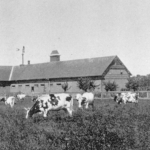On his land opposite the Lachine Rapids, W. W. Ogilvie had farm buildings constructed as well as cow sheds and barns. In 1895, Ogilvie was honoured with a silver medal from the Société d'agriculture Jacques-Cartier for the best maintained farm in the district. He was particularly fond of his Ayrshire cows.
When he died in 1900, the name of each of the cows was carefully recorded in the inventory of his assets. For example, the 4-year-old pedigree cow named Margaret of Lessnessock was worth $60; Pansy of Carston, of the same age, $40, and the one-year-old cow named Glenora Lady, $30. His horses, however, weren't given the same consideration, as they were assigned an overall evaluation without any particular distinction.
Milk, water and infant mortality
Without affirming that the Ogilvie farm had this problem, the milk production in those days was not all that good. A cow afflicted with tuberculosis could infect all those who drank its milk.
Between 1897 and 1911, in Montréal, one baby out of three died before the age of one year old. The infant mortality rate was still 14% in 1926 or almost double the rate in comparison to Toronto or New York. A good many of these deaths were due to illnesses of the digestive system, and particularly enteritis and diarrhea, which especially affected babies between one and six months old in poor families in Montréal—among French Canadians, for instance. Water and milk were the main causes of illnesses.
The gradual implementation of pasteurization in the milk in Montréal and the filtration of water by the City of Montréal greatly reduced the rate of infant mortality at the dawning of the 1930s.


